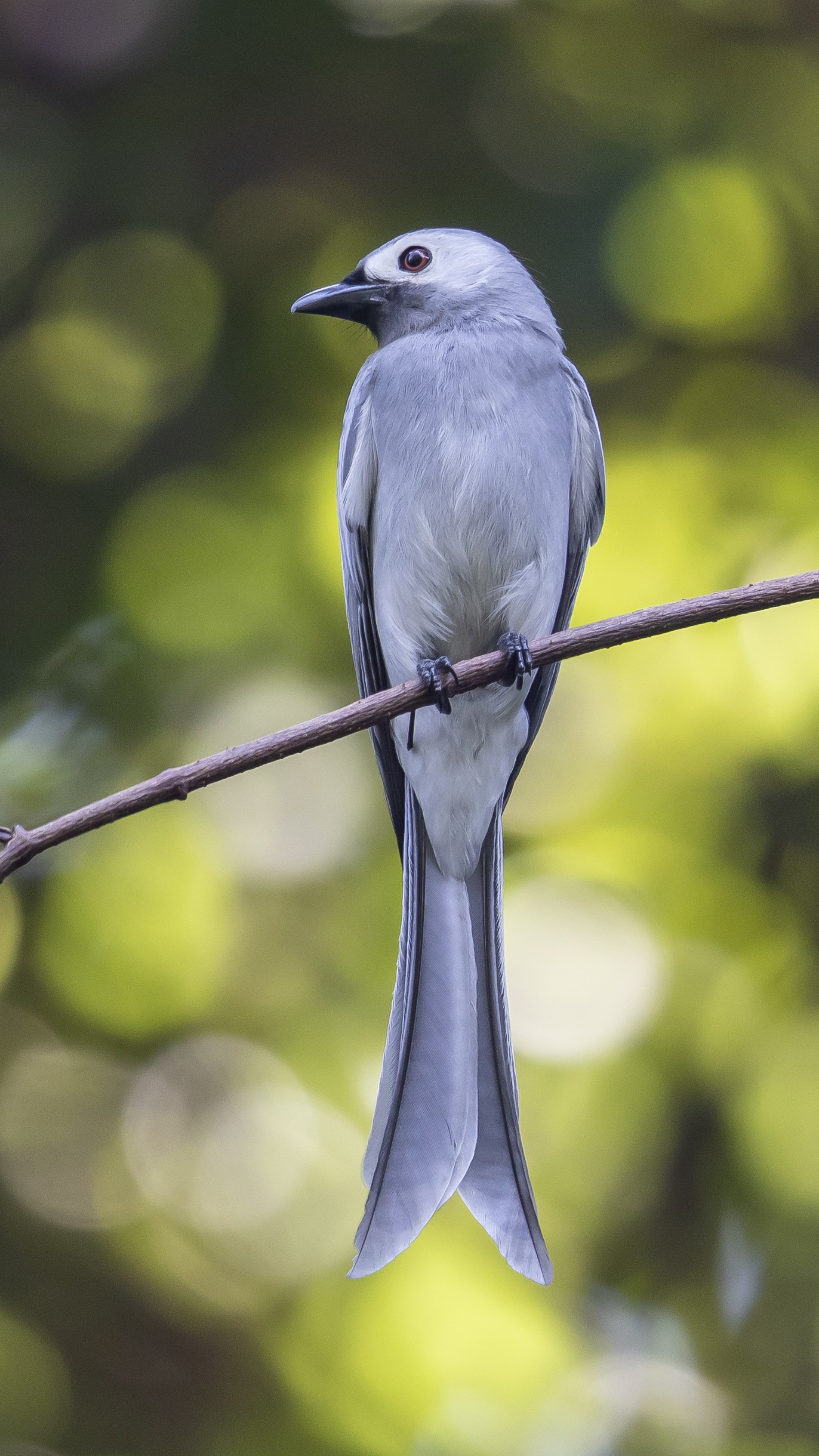IDENTIFICATION

Jan. 2008, FUNG Hon Shing. D. l. hopwoodi.
23-30 cm. Grey (varies from pale grey to dark steel-grey) with deeply forked tail. Plumage and size variable, depending on taxon.
D. l. hopwoodi is the darkest and largest race (26-30 cm) in HK. Blue-grey without gloss or a white patch on face, its tail is shorter and less deeply forked than the other two forms.

Oct. 2017, Matthew Kwan. D. l. leucogenis.
D. l. leucogenis (‘White-cheeked Drongo’) is pale grey, below becoming whitish on vent and undertail-coverts, with blackish frontal band and chin. Distinctive, large pure white oval patch around eye. Female less extensive white on face.
D. l. salangensis is similar but generally darker, with facial patch slightly darker and less well-defined. Ear coverts mostly grey. However, intergrades between these two forms also occur.
VOCALISATIONS
Diverse vocabulary. The most frequently heard call is a repeated rising ‘sweet’ sometimes interspersed with a lower-pitched ‘chee-too.’
DISTRIBUTION & HABITAT PREFERENCE
Occurs primarily in areas with large trees, either broadleaf forest, fung shui woodland or large gardens, though occasionally in more open country. Most frequently recorded in the Tai Mo Shan massif and Tai Lam Country Park. On migration, especially autumn, it also occurs in less-wooded, urban localities such as Ho Man Tin and offshore islands such as Po Toi and Tung Lung Chau.
Between the Winter Atlas surveys of 2001-05 and 2016-19 the distribution increased from 1.2% to 2.0% of 1km squares. The main increase that can be explained easily occurred in the Pat Sin Leng area, where it is assumed succession to forest was the driving force.
OCCURRENCE
Ashy Drongo is a scarce winter visitor that occurs from the second week of September to the third week of May. The lack of obvious passage peak (Figure 1) except perhaps in October suggests that wintering birds constitute the majority of records. Extreme dates are 11 September 1989 and 18 May 2011.
Although many records are simply assigned as ‘white-cheeked’ or ‘grey-cheeked,’ three subspecies are considered to occur, namely D. l. leucogenis, D. l. salangensis and D. l. hopwoodi. All are winter visitors with similar occurrence patterns. However, the latter two leave earlier in spring (e.g., second week of April instead of third week of May for leucogenis). D. l. leucogenis is regarded as the default taxon as approximately 96% of records in the period from 1999 to 2020 for which some indication of subspecies is provided refer to this form. D. l. salangensis and D. l. hopwoodi constitute approximately 2% each of the records during the same period.
Most records concern one to three birds. The highest counts are 20 on 3 April 2020 at Sai Kung and ten on 11 April 2019 on Po Toi. Both refer to leucogenis.
The earliest record of Ashy Drongo refers to a grey-cheeked individual at Happy Valley from 16 February to mid-April 1908 (Vaughan and Jones 1913) but there were no further records until the 1930s when there were several reports of both grey and white-cheeked individuals.
BEHAVIOUR, FORAGING & DIET
Mostly occurs in ones or twos, rarely up to four individuals. Unlike Hair-crested Drongo, which forages in the canopy, Ashy Drongo often hawks above tree tops and perches conspicuously on bare branches at the top of large trees. Wintering birds are characteristically solitary and often remain within a circumscribed area for several months; individuals apparently often return to the same site in subsequent winters. There are few data regarding diet, but it is known to prey on flying insects such as butterflies and wasps.
Vocalises most intensely shortly before and after sunrise before moving to a foraging site. May be seen perched in the open above the canopy taking advantage of late afternoon sun.
RANGE & SYSTEMATICS
Of the 14 subspecies, three occur in HK. D. l. leucogenis breeds in east and central China from south Liaoning to northeast Guangdong and winters in south China, north Laos, east Thailand, Cambodia, Tenasserim and the Malay Peninsula. D. l. salangensis breeds in areas south of the Yangtze River to the Fujian - Guangdong border and winters in Hainan, south Indochina, Thailand and the Malay Peninsula. D. l. hopwoodi breeds in east Himalayas, southwest and south China (from east Xizang to south Guangdong), north and central Myanmar to north Vietnam, and winters in south to west Bengal, south Assam, Bangladesh, south China (Hainan) and south Myanmar, north and east Thailand and south Laos (Rocamora & Yeatman-Berthelot 2020).
CONSERVATION STATUS
IUCN: Least Concern. Population trend unknown.
Figure 1.

Rocamora, G. and D. Yeatman-Berthelot (2020). Ashy Drongo (Dicrurus leucophaeus), version 1.0. In Birds of the World (J. del Hoyo, A. Elliott, J. Sargatal, D. A. Christie, and E. de Juana, Editors). Cornell Lab of Ornithology, Ithaca, NY, USA. https://doi.org/10.2173/bow.ashdro1.01
Vaughan, R. E. and K. H. Jones (1913). The birds of Hong Kong, Macao and the West River or Si Kiang in South-East China, with special reference to their nidification and seasonal movements. Ibis 1913: 17-76, 163-201, 351-384.

